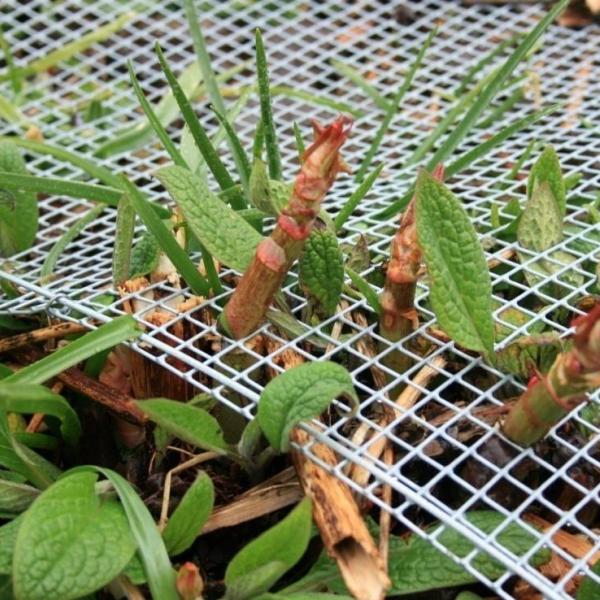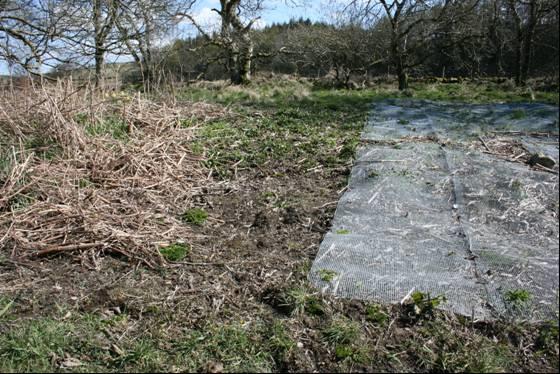
Author: Andrea Shortsleeve, Private Lands Habitat Biologist, VT Fish and Wildlife Department
There’s a patch of Japanese knotweed growing on the edge of a town park near my house that I see every morning when I walk my dog. It hasn’t started sending up green shoots yet this spring, but there can’t be too many more days before it does. For the past few years, this patch has been there, steadily growing and spreading each season, slowly creeping more interior into the forest each summer.
Both Japanese and Giant knotweed (Fallopia japonica and sachalinensis), the two species found here in Vermont, are natives to East Asia. While these plants can grow and exploit a range of site conditions, they seem most comfortable along riverbanks and roadsides here in Vermont, causing severe damage to our ecosystems. As it grows, knotweed forms extensive, dense mats of roots and stems, eliminating native vegetation. The loss of native shrubs, trees, and flowers impacts the insect, bird, and mammal populations that depend on those plants for food and nectar. Additionally, as the insect populations declines, the fish, birds, and mammals that feed on those insects suffer as well. And as native plants are eliminated from along the riverbanks, their root systems are, too. The ground beneath the thick patches of knotweed leave bare soil, increasing the risk of soil erosion into the waterways. And finally, the impenetrable vegetative wall created along the riverbanks all but eliminates the ability of wildlife to travel along the river corridor, a space which many species rely upon to safely move across the landscape.
These detrimental impacts of this invasive plant are well-known, and even so, I’ve worked with landowners who are reluctant to treat knotweed on their property. Some landowners like the way it grows because it provides a vegetative privacy fence between their houses and a road or a neighboring property. Some people believe knotweed flowers make exceptional honey, and some espouse how delicious the fresh shoots are to eat. Frankly, I feel that looking at knotweed in these ways can trivialize an incredibly damaging invasive plant and are often short-sighted. There is a variety of native and non-invasive plants available to provide those same benefits without creating ecological damage. However, I do recognize that hyping these aspects of knotweed is a way for landowners find a silver lining in having an infestation on their properties, an often-overwhelming situation.
Knotweed is notoriously difficult to control and often seems indifferent to many treatment methods. VTInvasives.org is a great resource to look at different methods to treat knotweed, but each suggested method offers varying levels of success calling for a variety of resources and time.
This year, I’ve decided to do something about the little patch of knotweed on my morning walk, and I’m planning to try a new method to treat it. The method has been offered commercially for a few years in Great Britain, a country where Japanese knotweed has significant economic and environmental impacts. Knotweed in Britain routinely cracks the pavement in roads, causes damage to retaining walls and building foundations, and lowers property values. Mortgage companies have begun to refuse to lend on properties that are affected by Japanese knotweed due to the high threat of damage to residential homes the country has seen. Luckily, we are not in as grave of a situation here across the pond, but my point is that if Great Britain has been seeing success with a treatment method, it’s probably worth looking at.
Full disclosure: I’ve never actually tried this method, nor do I personally know anyone who has, either. However, it strikes me as a low-cost, low-energy, low-risk method to try and tackle an invasive that has brought many weed warriors to their knees. So, what’s the harm? This method, called MeshTech, was developed by Dr. Eric Donnelly and Japanese Knotweed Solutions Ltd (This is not a promotion, but I want to give credit when it’s due). A simple Google search reveals much more in-depth information about this technique and its development than I can provide here, but I’ll run through a short explanation.
This new (new-to-me) method involves selecting a patch of knotweed and clearing out the surface growth from previous growing seasons. The cleared-out section is then covered with a wire fence mesh with ½ inch x ½ inch openings. The fencing material will have to be fastened down in some method so it will stay put throughout the growing season. And that’s all you do. Simple.

Photo Credit: Japanese Knotweed Solutions Ltd.
The theory is that the knotweed stems will emerge from buds on the underground rhizome in early spring and will grow through the steel mesh. As the stems continue to grow, they will expand in diameter. At a certain point, the stems will push against the steel mesh and girdle themselves. The surface growth (stems and leaves) of the plant wilts and will eventually die, but the rhizome will continue to push new stems up through the ground (and wire mesh). This will continually kill the stems and will lead to the depletion of rhizome carbohydrate stores, which are required by the stems for growth. This cycle will repeat until the end of the growing season, when the plant enters a period of dormancy. Normally, the knotweed will have a plentiful store of carbohydrates stored in its rhizome to begin growing again in the spring. However, after a season of trying to outsmart the steel mesh on top of it, the knotweed will not have any energy stored up to continue growing in the next season.
The company Japanese Knotweed Solutions Ltd. indicates that there will be a noticeable difference in the vigor and growth of the plant after the first year of trying the MeshTech method, but total control of the plant will still take over 5 years. Other control methods have similar timelines to see semi-permanent results, but this method could have potential to make a difference in knotweed infestations where other methods such as chemical or mechanical treatments are not appropriate. I know that I’ll be able to handle this method while I juggle all of life’s other responsibilities, and I encourage readers to try this out and let me know how it works for them. It seems to be a low-cost and low-effort method to obtain promising results on troublesome knotweed patches. And that sounds, as the British would say, brilliant.
Photo Credits: Japanese Knotweed Solutions Ltd.